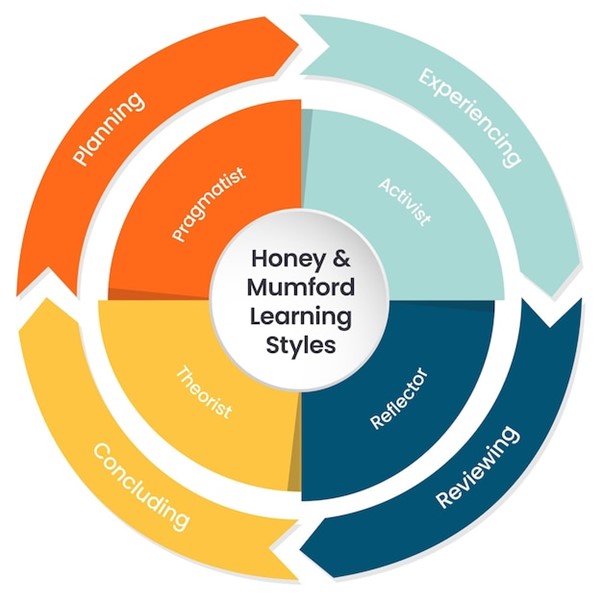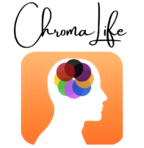[read-time]

Introduction to Honey and Mumford Learning Styles
In the ever-evolving landscape of personal and professional development, understanding your learning preferences has become increasingly crucial. The Honey and Mumford Learning Styles theory, developed by Peter Honey and Alan Mumford, offers a comprehensive framework to identify and leverage your unique learning tendencies. This approach recognizes that individuals have distinct preferences for acquiring, processing, and retaining information, and by understanding these preferences, you can optimize your learning experiences.
The Honey and Mumford Learning Styles theory categorizes learners into four distinct styles:
- Activists: You thrive on new experiences and embrace challenges head-on. You prefer to learn by doing, engaging in hands-on activities, and actively participating in group discussions.
- Reflectors: You are thoughtful and analytical, preferring to observe and reflect before taking action. You value time for contemplation and seek to understand concepts from multiple perspectives.
- Theorists: You appreciate logical and structured approaches, seeking to understand the underlying principles and theories behind concepts. You excel at analyzing information and creating conceptual models.
- Pragmatists: You are practical and solution-oriented, preferring to apply knowledge in real-world situations. You value learning experiences that offer tangible and immediate benefits.
By recognizing your dominant learning style(s), you can tailor your approach to learning, enabling you to absorb and retain information more effectively.
Overview of Personality Color Tests
Complementing the understanding of learning styles, personality color tests offer insights into an individual’s unique traits, preferences, and communication styles. These tests are based on the premise that personalities can be represented by distinct colors, each symbolizing specific characteristics and behaviors.
By identifying your dominant personality color(s), you gain valuable insights into your strengths, weaknesses, communication preferences, and how you interact with others, fostering self-awareness and personal growth.
Understanding the Honey and Mumford Learning Styles
To truly comprehend the Honey and Mumford Learning Styles, let’s delve deeper into each style:
- Activists:
- You are open-minded and embrace new experiences with enthusiasm.
- You thrive in situations that require spontaneity and flexibility.
- You prefer to learn through hands-on activities, group discussions, and role-playing exercises.
- You may struggle with theoretical concepts or lengthy lectures.
- Reflectors:
- You are thoughtful and cautious, preferring to observe and reflect before taking action.
- You value time for contemplation and seek to understand concepts from multiple perspectives.
- You prefer to learn through self-study, reading, and observing others.
- You may find it challenging to make decisions quickly or engage in highly interactive learning environments.
- Theorists:
- You appreciate logical and structured approaches to learning.
- You excel at analyzing information and creating conceptual models.
- You prefer to learn through lectures, research, and theoretical discussions.
- You may struggle with ambiguity or situations that lack clear guidelines.
- Pragmatists:
- You are practical and solution-oriented, preferring to apply knowledge in real-world situations.
- You value learning experiences that offer tangible and immediate benefits.
- You prefer to learn through case studies, problem-solving exercises, and practical demonstrations.
- You may find it challenging to engage with abstract concepts or theoretical discussions.
By understanding your dominant learning style(s), you can tailor your approach to learning, enabling you to absorb and retain information more effectively.
The Connection between the Two Tests

While the Honey and Mumford Learning Styles and personality color tests may seem distinct, there exists a remarkable synergy between the two. By understanding both your learning style and personality color, you can unlock a deeper level of self-awareness and tailor your approach to learning and personal development.
Here’s how the two frameworks can complement each other:
- Activists and Extroverted Personalities: Activists, who thrive on new experiences and hands-on activities, may resonate with extroverted personality colors like Orange, or Fiery Red. These individuals tend to be energetic, spontaneous, and enjoy interactive learning environments.
- Reflectors and Introverted Personalities: Reflectors, who value observation and contemplation, may align with introverted personality colors like Green. These individuals prefer self-study, research, and time for reflection.
- Theorists and Analytical Personalities: Theorists, who appreciate logical and structured approaches, may resonate with analytical personality colors like Green. These individuals excel in understanding underlying principles and creating conceptual models.
- Pragmatists and Practical Personalities: Pragmatists, who prefer practical and solution-oriented learning, may align with personality colors like Blue. These individuals value learning experiences with tangible and immediate benefits.
By combining the insights from both frameworks, you can tailor your learning approach to align with your preferred learning style and leverage your personality strengths, ultimately enhancing your overall learning experience and personal growth.
Benefits of Understanding the Synergy Between the Two
Embracing the synergy of the two tests offers numerous benefits:
- Personalized Learning Experiences: By understanding your unique learning style and personality traits, you can create personalized learning experiences that cater to your preferences, strengths, and areas for growth.
- Enhanced Self-Awareness: Gaining insights into your learning tendencies and personality characteristics fosters greater self-awareness, enabling you to identify your strengths, weaknesses, and areas for personal development.
- Improved Communication and Collaboration: Understanding the learning styles and personality colors of others can facilitate more effective communication, collaboration, and teamwork by allowing you to adapt your approach and leverage diverse perspectives.
- Optimized Learning Strategies: By aligning your learning strategies with your dominant learning style and personality traits, you can maximize your ability to absorb, retain, and apply new knowledge effectively.
- Increased Motivation and Engagement: When learning experiences resonate with your preferences and align with your personality, you are more likely to stay motivated, engaged, and committed to your personal and professional growth.
By embracing the synergy between these two frameworks, you can unlock a powerful tool for self-discovery, personal growth, and lifelong learning.
Incorporating Honey and Mumford Learning Styles and Personality Color Tests in Education

The integration of Honey and Mumford Learning Styles and personality color tests in educational settings can revolutionize the way students learn and develop. By acknowledging and catering to individual preferences and traits, educators can create more engaging and effective learning experiences.
Here are some strategies for incorporating these frameworks into education:
- Personalized Learning Plans: Assess students’ learning styles and personality colors to develop personalized learning plans that align with their unique needs and preferences.
- Diverse Teaching Methods: Implement a variety of teaching methods to cater to different learning styles, such as lectures, group discussions, hands-on activities, and self-study opportunities.
- Collaborative Learning Environments: Foster collaborative learning environments that encourage students with different personality colors to work together, leveraging their diverse strengths and perspectives.
- Tailored Assessment Strategies: Design assessment strategies that align with students’ learning styles and personality traits, allowing them to demonstrate their knowledge and skills in ways that resonate with their preferences.
- Professional Development for Educators: Provide professional development opportunities for educators to understand and apply the Honey and Mumford Learning Styles and personality color tests, enabling them to create more inclusive and effective learning experiences.
By embracing these frameworks, educational institutions can foster a more inclusive and engaging learning environment, empowering students to reach their full potential and develop essential skills for personal and professional success.
Applying the Synergy in the Workplace
The synergy between Honey and Mumford Learning Styles and personality color tests can also be leveraged in the workplace to enhance employee development, team dynamics, and organizational effectiveness.
Here are some practical applications:
- Tailored Training Programs: Design training programs that cater to different learning styles and personality traits, ensuring employees can effectively acquire and retain new knowledge and skills.
- Effective Communication and Collaboration: Utilize insights from personality color tests to facilitate better communication, collaboration, and conflict resolution among team members with diverse personalities.
- Personalized Career Development Plans: Develop personalized career development plans for employees based on their learning styles and personality traits, enabling them to identify and pursue growth opportunities that align with their strengths and preferences.
- Team Building and Diversity Initiatives: Incorporate learning styles and personality color assessments into team-building activities and diversity initiatives, fostering greater understanding, respect, and appreciation for individual differences.
- Leadership Development: Enhance leadership development programs by incorporating insights from both frameworks, enabling leaders to adapt their communication and management styles to effectively motivate and engage diverse teams.
By leveraging the synergy between Honey and Mumford Learning Styles and personality color tests, organizations can create a more inclusive and engaging work environment, optimize employee development, and foster a culture of continuous learning and growth.
The Takeaway
Embracing the Power of Understanding Learning Styles and Personality Color Tests
In the ever-evolving landscape of personal and professional development, understanding your learning style and personality traits can be a game-changer. By embracing the synergy between the Honey and Mumford Learning Styles and personality color tests, you unlock a powerful tool for self-discovery, personalized growth, and effective collaboration.
Remember, every individual is unique, and by tailoring your approach to align with your preferences and strengths, you can maximize your potential for success. Whether in educational settings, the workplace, or your personal life, leveraging these insights can lead to more engaging learning experiences, enhanced communication, and a deeper understanding of yourself and others.
Embark on a transformative journey of self-discovery and growth by exploring the synergy between the Honey and Mumford Learning Styles and personality color tests. Unlock your full potential by embracing your unique learning preferences and personality traits, and let this powerful combination guide you towards personal and professional success. Take the first step today by assessing your learning style and personality color, and start tailoring your development path to align with your authentic self.
FAQs
What are Honey & Mumford Learning Styles?
Honey & Mumford Learning Styles is a model developed by Peter Honey and Alan Mumford in the 1980s. It categorizes learners into four types: Activists, Reflectors, Theorists, and Pragmatists. Each style represents a preferred way of learning and processing information.
What are Personality Color Tests?
Personality Color Tests, such as the True Colors personality assessment, use color associations to categorize personality types. The four main colors typically used are Blue , Red, Green, and Yellow.
How do these two models complement each other?
The synergy between these models lies in their ability to provide a more comprehensive understanding of an individual’s learning preferences and personality traits. While Honey & Mumford focuses on learning styles, Personality Color Tests offer insights into broader personality characteristics, creating a more holistic view of the individual.
Can there be correlations between specific learning styles and color personalities?
Yes, there can be correlations, although they’re not absolute. For example:
- Activists (Honey & Mumford) might align with Orange personalities (spontaneous, energetic)
- Reflectors might share traits with Blue personalities (thoughtful, empathetic)
- Theorists could have similarities with Green personalities (analytical, logical)
- Pragmatists might relate to Green personalities (practical, organized)
How can understanding both models benefit personal development?
Understanding both models can lead to:
- Enhanced self-awareness
- Improved learning strategies
- Better communication skills
- More effective team dynamics
- Personalized approaches to problem-solving and decision-making
Are these models scientifically validated?
While both models are widely used in personal development and organizational settings, it’s important to note that they are not as rigorously scientifically validated as some other psychological assessments. They should be used as tools for self-reflection and discussion rather than definitive categorizations.
How can educators or managers use these models together?
Educators and managers can use these models in combination to:
- Tailor teaching or training methods to individual preferences
- Create diverse and balanced teams
- Improve communication and conflict resolution
- Develop more comprehensive personal development plans
- Enhance overall group dynamics and productivity
